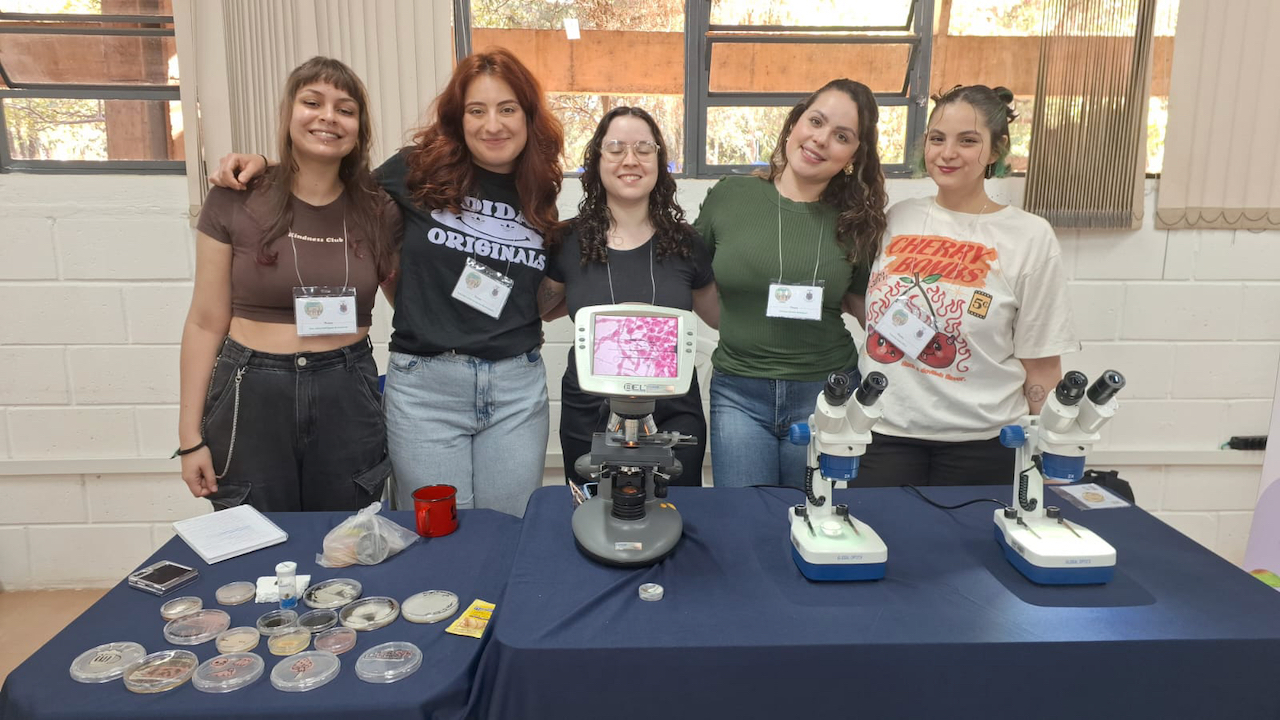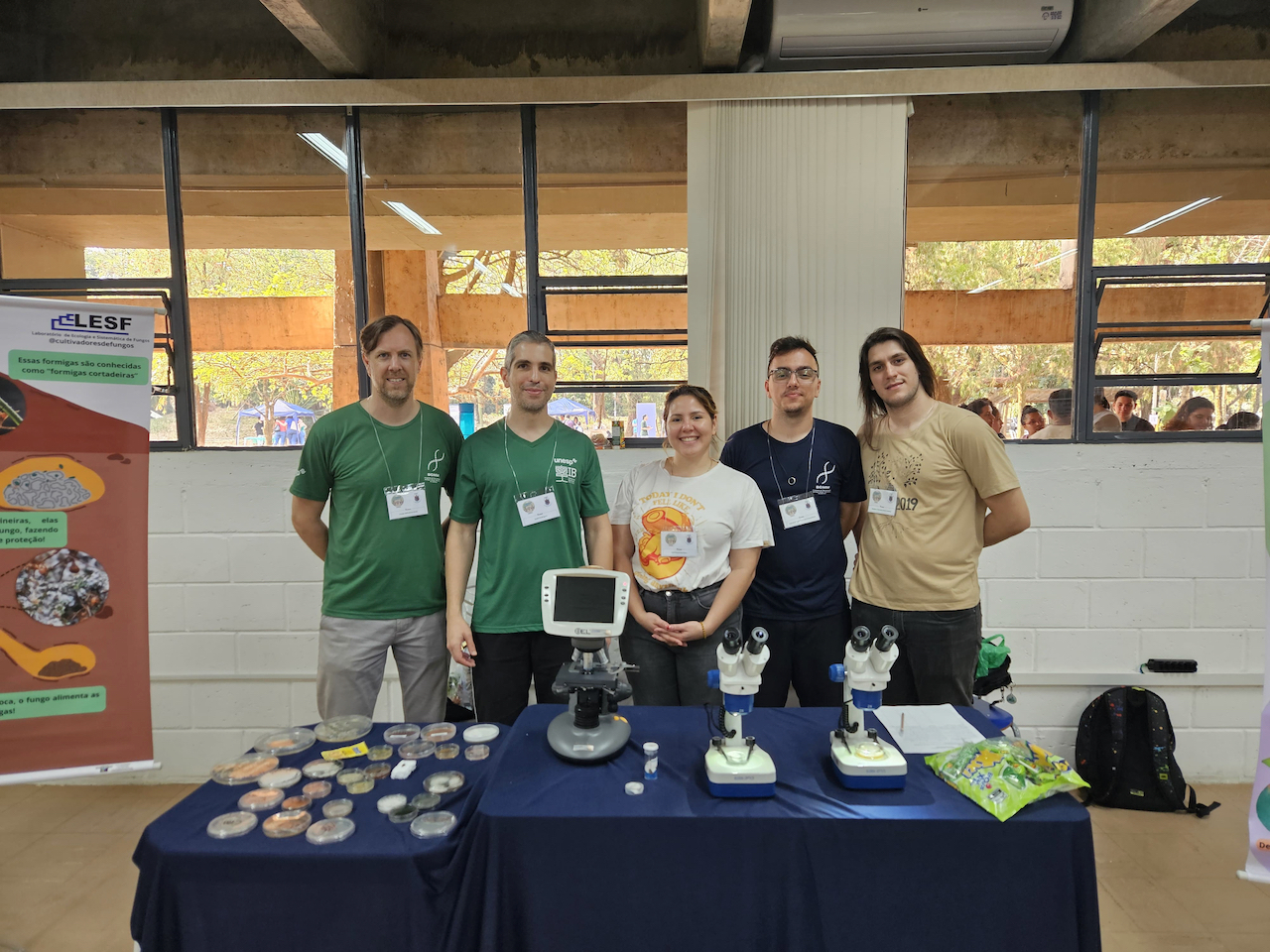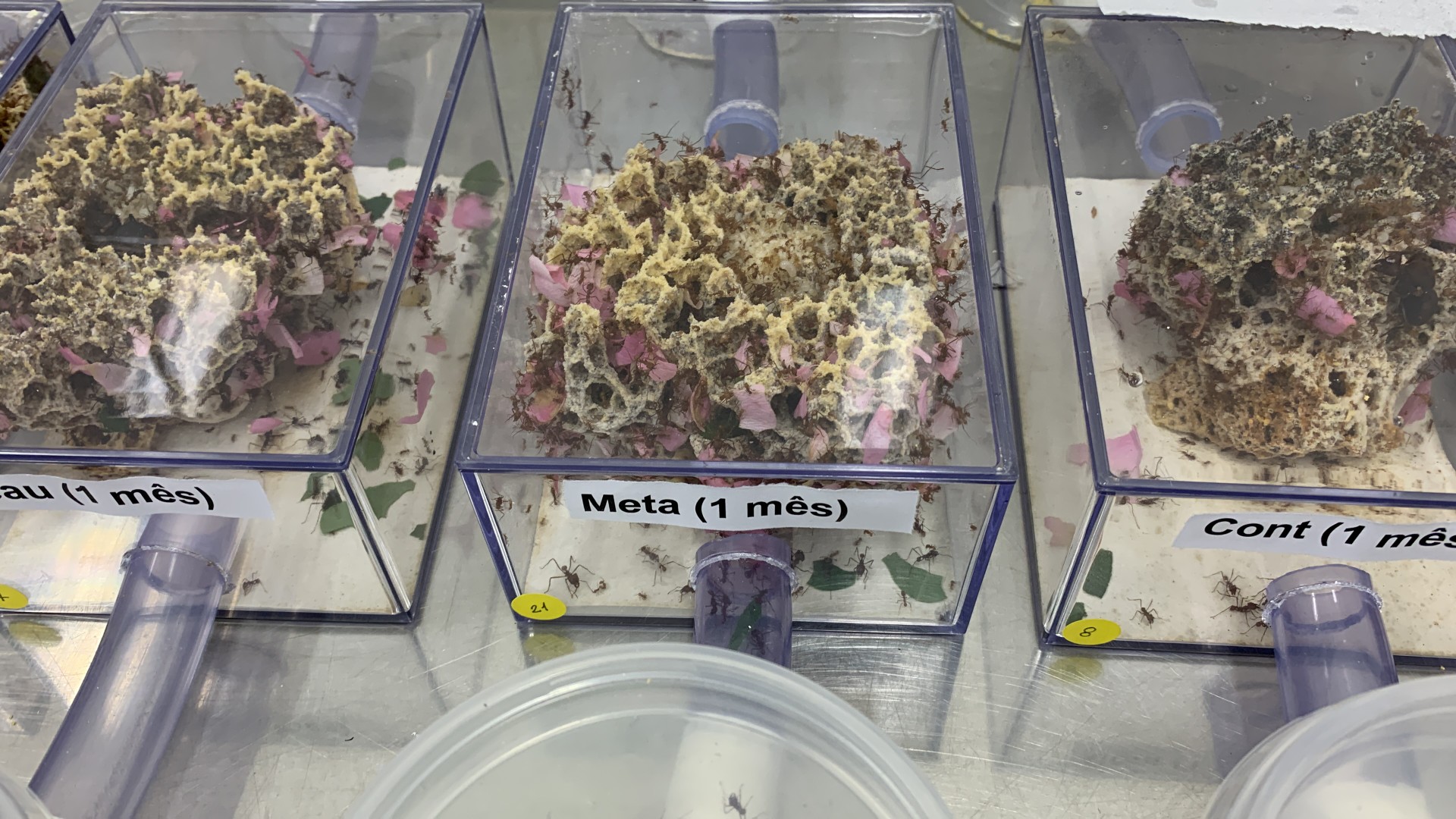Laboratory of Fungal Ecology and Systematics
August 2025
UNESP Portas Abertas
Once more LESF team did outreach on our Campus.


March 2025
Sauvas in the spotlight of social immunity research
Leaf-cutting ant Atta sexdens detect and fight off contaminants even after 30 of the initial exposure. This cool finding is published in Proceedings B. Our former team member Aryel Goes lead the study. Way to go Aryel!! This research disseminated in academic and popular media.
André Julião | Agência FAPESP – Estudo conduzido por pesquisadores da Universidade Estadual Paulista (Unesp) e colaboradores revela que as formigas saúva-limão (Atta sexdens) apresentam comportamentos que vão além da chamada imunidade social, ou seja, da capacidade de detectar patógenos e tentar se livrar deles para o bem da colônia.
Em artigo publicado na revista Proceedings of the Royal Society B, os cientistas relatam que esses insetos são capazes de reconhecer um fungo patogênico com o qual já tiveram contato – mesmo 30 dias após a primeira contaminação – e combatê-lo com ainda mais intensidade. Para isso, aumentam comportamentos de limpeza e recrutam mais operárias para a atividade, caracterizando indícios do que poderia ser chamado de “memória imune social”.
“Se considerarmos a colônia como um superorganismo, esses comportamentos seriam como o sistema imune. Da mesma forma que nossas células de defesa atacam invasores, como vírus e bactérias, as operárias combatem infecções que podem prejudicar a colônia”, explica Aryel Goes, primeiro autor do estudo, realizado como parte do seu mestrado no Instituto de Biociências (IB) da Unesp, em Rio Claro, com apoio da FAPESP.
“O que estamos mostrando é que o sistema imune social das formigas pode guardar informações de infecções prévias ao mesmo patógeno, um fenômeno visto em nossas células imunes, mas que em colônias de formigas ocorre em nível comportamental”, completa.
Em um dos experimentos realizados, as colônias foram expostas a um mesmo patógeno uma primeira vez, novamente após sete dias e, por fim, depois de um mês. Esta última exposição teve a resposta mais intensa e mais rápida, com mais formigas envolvidas tanto na limpeza delas mesmas como na do fungo que cultivam para comer.
A saúva-limão é uma formiga-cortadeira, grupo que possui relação de mutualismo com fungos, cultivados por elas dentro das colônias. Os fungos, em contrapartida, fornecem nutrientes para as formigas (leia mais em: agencia.fapesp.br/52937).
Dos quatro patógenos testados, dois eram prejudiciais às formigas e dois aos fungos cultivados. O estudo integra projeto apoiado pela FAPESP e coordenado por André Rodrigues, professor do IB-Unesp.
Em um segundo experimento, os pesquisadores expuseram outras colônias ao patógeno, repetiram a contaminação depois de sete dias e, então, a terceira apenas depois de 60 dias do primeiro contato. As respostas foram bem menos intensas do que nas colônias reexpostas com 30 dias.
“Diferentemente do nosso sistema imune, que em alguns casos responde expressivamente a um patógeno específico mesmo depois de muitos anos da primeira exposição, a memória imune social das formigas tem um prazo menor, por isso precisa ser constantemente exposta ao patógeno para que a informação continue existindo”, completa Goes, que atualmente realiza doutorado na Ohio State University, nos Estados Unidos.

Pesquisadores realizaram experimentos com quatro patógenos diferentes em 45 colônias de saúva-limão (foto: Aryel Goes/Ohio State University)
Resposta específica
No terceiro experimento, os pesquisadores verificaram a especificidade da resposta das formigas. Para isso, sete dias após a contaminação por um patógeno, expuseram as formigas a outro, diferente. Os comportamentos de limpeza e o recrutamento de outras operárias foram menos intensos quando este segundo patógeno entrou em cena.
Então, na semana seguinte, foi aplicado o primeiro patógeno novamente na colônia. O retorno suscitou uma reação moderada, parecida à da primeira infecção, e bem menos intensa do que aquela das formigas que tiveram um terceiro contato 30 dias depois do primeiro.
“Uma hipótese é que a saúva-limão tenha reduzido a resposta higiênica para evitar espalhar o novo patógeno para o resto da colônia. Isso porque o altruísmo de limpeza, em que as formigas lambem umas às outras para se livrar de patógenos, pode também espalhar novos contaminantes. Por isso, elas teriam tido mais cautela numa segunda infecção totalmente nova para a colônia”, conta Rodrigues, pesquisador associado ao Centro de Pesquisa em Biodiversidade e Mudanças do Clima (CBioClima), um dos Centros de Pesquisa, Inovação e Difusão (CEPIDs) apoiados pela FAPESP.
Uma questão que os experimentos poderiam suscitar é se os comportamentos higiênicos não seriam simplesmente respostas das formigas a uma substância desconhecida, não necessariamente patogênica.
Para verificar essa possibilidade, os pesquisadores aplicaram uma solução que não causa nenhum mal às formigas nem aos fungos em cinco colônias, como forma de controle. As respostas higiênicas foram as menos intensas entre todos os experimentos nas 80 colônias analisadas em todo o estudo, mostrando que as formigas realmente reconhecem patógenos e as diferentes exposições.
Uma hipótese aventada pelos pesquisadores é que a imunidade social observada no estudo possa indicar uma melhoria na eficiência da remoção de contaminantes, afetando positivamente a sobrevivência do grupo.
Como não há informações sobre como essas respostas variáveis afetam a sobrevivência das formigas, ainda não é possível determinar se elas constituem de fato uma memória imune social, mas novos experimentos poderiam verificar essa possibilidade.
“As saúvas-limão são adaptadas a áreas abertas, por isso se beneficiam de monoculturas, constituindo uma praga. Os comportamentos de limpeza são alguns dos impeditivos para se fazer um controle biológico efetivo, sem utilização de inseticidas químicos. Compreender a imunidade social das saúvas pode ajudar a desenvolver controles mais eficazes e ecologicamente corretos”, encerra Rodrigues.
O artigo Exploring immune memory traits in the social immunity of a fungus-growing ant pode ser lido em: royalsocietypublishing.org/doi/10.1098/rspb.2024.1097.
October 2024
Field work in FLONA Carajás
The LESF team and collaborators (Nicole Gerardo and Jeffrey Sosa-Calvo) did an awesome field work in Floresta Nacional de Carajás, in Parauapebas-PA, Brazil. The team spent 15 days collecting and studying fungus-growing ants and their associate fungi


July 2024
UNESP Portas Abertas
LESF will showcase research on attine ants and the associate microbiome. Visit our Campus for exciting science and lots of fun...

May 2024
Jornal da UNESP depicts FAPESP grant by LESF
Check this news here (in Portuguese). LESF congratulates all students and alumni for taking part of the grand quest to deciphere the microbiome of attine ant gardens.
February 2024
X Brazilian Mycological Congress
The lab joined for a mass attendance in the X Brazilian Mycological Congress held in Belo Horizonte (MG), Brazil. Time for lots of science, discussion, reunion and...fun :-)

December 2023
Outreach
Unraveling the hidden world of attine ants: a short essay on yeasts associated with these insects by former LESF member Rodolfo Bizarria Jr. Check this outreach article here.
September 2023
Outreach
Underground gardens (Jardins subterrâneos). Photo by Mariana Barcoto published in Revista Pesquisa FAPESP

June 2023
Outreach
Organized by TV UNESP, LESF grad students together with the postdoc Diego Assis discuss why projects directed to study microbes in association with leaf-cutting ants is a fascinating and important task.
March 2023
Podcast by Mariana Barcoto
#18 A função vital das bactérias para as formigas. Check the podcast here.
February 2023
Go, go LESF... new paper by Maria Jesus Sutta Martiarena !!
Check this paper in Microbial Ecology brings awesome photos of bacterial biolfims on attine ant fungal cultivar.
January 2023
New LESF members: Mateus Oliveira da Cruz and Raphael Affonso
Wecolme to LESF, hope you have a brillant path ahead in your academic life :-)
June 2022
Outreach
LESF grad students and our collaborator Dr. Mauricio Bacci Jr. discussed insects, microbial symbionts and science. Check it out......
August 2021
FAPESP scholarship awarded!
Mariana was awarded a FAPESPPhD scholarship. Congratulations!
February 2020
FAPESP scholarship is in the oven!
Rodolfo had his FAPESP PhD scholarship approved. Congratulations!
January 2020
Dr. Pepijn Kooij joined LESF as research associate for a year.
Greetings, Pepijn! Welcome to our group. Pepijn is in our lab under the CAPES/PrInt program.
May 2019
New student joins LESF for a Master degree!
Welcome to our group, Morgana Turunday!
March 2018
LESF member Beatriz and Maryana!
Both had scholarships approved for their Master degree. Congratulations!
March 2018
New paper published by LESF member
Lorena's paper is out in Mycological Progress. Check her publication here.
February 2018
New paper published by LESF member
Tássio's paper (former Ph.D. student) is out in BMC Genomics. Check his publication here.
January 2018
LESF member Tatiane!
Tatiane had her CAPES scholarship approved. Congratulations!
November 2017
LESF member Rodolfo!
Rodolfo had his FAPESP scholarship approved. Congratulations!
July 2017
LESF member Bruna!
Bruna had her FAPESP scholarship approved. Congratulations!
April 2017
New paper published by LESF member
Sadala's first paper describes how Escovopsis and Escovopsioides fungi interact with the fungus cultivated by leaf-cutting ants. Check this publication here.
September 2016
New fungal disease in ant fungus gardens
Mariana Barcoto's first paper describes how Syncephalastrum fungi can impact the fungiculture by attine ants. Check this publication here.
April 2016
Fungi and attine ant gardens
How many fungi one can find in an ant colony? Check our latest publication here.
January 2016
New Trichoderma species from ant colonies
Our student from Peru, Quimi Montoya, discovered three new species from attine ant colonies. You find this awelsome LESF publication here.
November 2015
Fungal parasites in leaf-cutting ant colonies
Check this news published by FAPESP about our lastest research paper - Meirelles et al. (2015). Also, check the documentary about our lab.